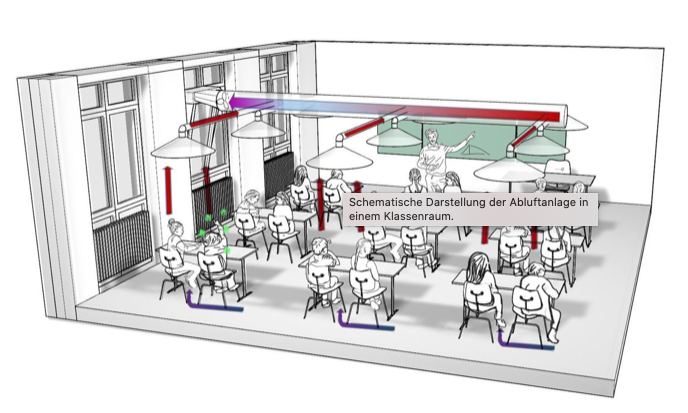
Researchers at the German Max Planck Institute of Chemistry have built a ventilation system that can remove up to 90% of aerosols in classrooms. The best thing about it is that you can just buy the parts you need from a DIY store. The researchers maintain that this smart and inexpensive system also offers the solution to the well-known problem of ab over-abundance of CO2 in classrooms. Construction blueprints of the system will soon be available online from the institute free of charge.
It is now generally assumed that corona can also spread through small droplets and aerosols in the air. This can ultimately lead to infections, especially in classrooms. This path of infection should be largely cut off with the filter system that researchers from the Max Planck Institute for Chemistry have tested together with the Integrated Comprehensive School Mainz-Bretzenheim.
Simple construction
It works on the principle that every human being produces warm air that rises upwards. If this airflow is directed outdoors, it will take aerosol particles and any coronaviruses along with it.
Construction is also very simple. It was achieved with materials from the DIY construction market that amounted to approximately €200. A funnel hangs from the ceiling above each table which is connected with a tube. All tubes lead to a central tube. This in turn extends through a window to outdoors. A fan at the end of the tube ensures that the air is actively directed outside.
Aerosols are captured above each table
The construction was devised by Frank Helleis, whose wife is a teacher in Mainz. She was also the one who contacted the school. “It sounded so simple and convincing that we immediately decided to participate,” says Roland Wollowski. He is the principal of the Integrated Comprehensive School Mainz-Bretzenheim. This soon resulted in a prototype that was built by Frank Helleis and his colleagues in a classroom during the summer and which has since been tested.

Smart alternative
“Our measurements have shown that the air extraction system with the covers is continuously removing more than 90% of the aerosols,” says Helleis. Although the system also works without the funnel-shaped covers above the individual tables, these collect the particles there in a more targeted manner. The physicist has demonstrated this with aerosol spectrometers on artificially generated aerosols.
Helleis consciously designed the system for practical applications. Because of the low costs of materials and operating costs, it could offer a smart alternative to ventilation and expensive filter systems. Moreover, the system is modular. As it requires only a small amount of space – just a power outlet and a tilt window or a skylight are required – it is also suitable for use in, for example, gymnasiums. The system is now also being tested in other schools in Rhineland-Palatinate in Germany.
Manual will be online soon
At the moment, it still requires some skill to build the system. Frank Helleis and his colleagues are putting together a manual for this. This will shortly be published on the Max Planck Institute for Chemistry website. There is already a contact form there where interested parties can order the instructions for free.
Frank Helleis, who is known as a creative tinkerer at the Max Planck Institute in Mainz, is convinced that the system will remain in use after the pandemic. “Our system also solves the long-standing CO2 problem that exists in classrooms. Not only does it transport aerosols outdoors, but it also reduces CO2 accumulation so that students can concentrate better on their lessons.”
Image: Diagram showing the system in a classroom. © Andrea Koppenborg







